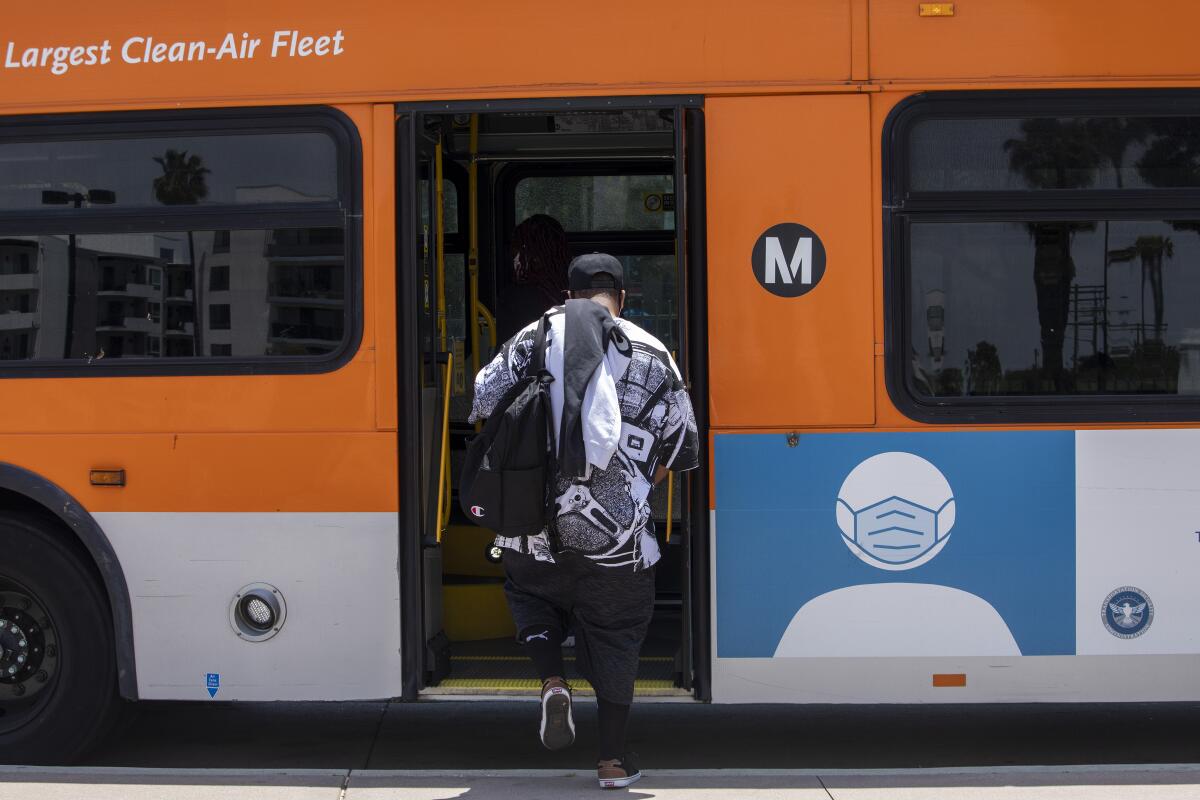Column: Imagine a Los Angeles where the buses and subways are free

Is it time to make the subways and buses free?
Los Angeles County is moving down that path, slowly. The idea’s been kicking around for several years, but a pilot program just got underway — for K-12 students only, and only at participating schools and school districts — in recent weeks. Next up: more K-12 schools and then perhaps community college students as well. After that, the program will, proponents hope, be expanded to provide free service to low-income riders.
And if all goes well during what could be a two-year experiment, the ultimate goal is to eliminate fares on Metro’s buses and subways altogether. L.A. would be the first big city in the country to take such a radical step.
The “fareless system initiative” is an appealing idea. Los Angeles absolutely needs to get people out of their cars and onto the buses and subways, reducing traffic, air pollution and carbon emissions. Economics 101 tells us that doing away with fares would encourage that by making driving relatively more expensive as transit becomes cheaper.
Furthermore, subways and buses are ridden mostly by low-income Angelenos, disproportionately people of color, many of them carless and transit-dependent. The median household income of L.A. Metro riders is $19,325. For many, the cost of transportation is not insignificant as they travel to jobs, schools and medical appointments each day.
Besides — and this is more of a philosophical issue — mass transit is a public good that a lot of people feel should be funded by and available to all.
“Just as we provide our sidewalks and roads to be used without direct costs, it’s time to consider looking at transit the same way,” said Mayor Eric Garcetti at the Metro board of directors meeting in May.
But before we jump, there are important questions that need to be answered.
Will eliminating fares really boost ridership? How much revenue will be lost and how will it be made up? Will free transit lead to service cutbacks or reduced reliability or, God forbid, higher taxes?
Before the pandemic, in 2019, Metro counted 1.2 million daily weekday passenger boardings on average. But ridership had been declining; it fell 17.8% from 2014 to 2018, according to UCLA’s Institute of Transportation Studies.
Currently, subway or bus fare is $1.75 per ride, or $100 for a monthly pass. It adds up to about $250 million to $300 million annually (or it did before COVID).
That’s a lot of money to give up voluntarily, but it’s actually only a fraction — 13% in 2019 — of the full cost of providing bus and subway service.
It’s not clear exactly how the forgone millions would be made up if fares were eliminated. Metro officials said early on they wouldn’t seek further sales tax increases. They argued that state and federal grants, reduced costs related to fare collection and enforcement, new advertising sales and other initiatives would cover the difference. Others suggest that implementing congestion pricing for drivers and using some of that money could help fill the gap. Whether those are realistic or imaginary solutions remains to be seen.
Originally, proponents of free transit — including former Metro CEO Phil Washington, who described it as a “moral obligation” — had hoped to expand the pilot program to low-income riders by January 2022. But at its May meeting, the Metro board got nervous about the costs, including the impact on existing operations and on the county’s smaller municipal transportation systems. The board ordered up a final financial plan before moving forward.
How quickly — or whether — the pilot program will be expanded will become clearer at the board’s late September meeting.
Metro says eliminating fares could be “the easiest and quickest way” to increase ridership, noting that when fares were reduced from 85 cents to 50 cents for three years in the 1980s under Proposition A, ridership climbed from 359 million annual boardings to more than 500 million. When fares rose again, ridership dropped.
But fares are not necessarily the biggest obstacle to ridership these days; rather, it’s the quality of service. Buses are not frequent enough or reliable enough. Subway lines are not sufficiently built out. The AllTransit Gap Finder, a data tool that rates transit service, says 70.9% of residents in the city of Los Angeles are underserved by transit compared with 28.4% in New York and 8.8% in San Francisco.
“Unfortunately there’s not a lot of evidence that people will get out of their cars and into transit even if it were free,” says Genevieve Giuliano, a transportation expert at USC’s Sol Price School of Public Policy. “A trip by car often takes half the time it takes by transit. If people know that in five to seven minutes the bus will come, that’s one world. But that’s not the world we’re in in Los Angeles.”
Proponents of eliminating fares say they’re working simultaneously on other efforts — including the “Better Bus Program,” the “NextGen Bus Initiative” and 15 new bus or train lines that recently opened or are being planned — to improve the rider experience and enhance reliability.
There’s more to learn. But I’m strongly in favor of the pilot. In fact, this is exactly what pilot programs are for — careful experimentation and rigorous information-gathering.
Here’s what should be studied: Is ridership climbing? Are lives being improved? Are fewer cars on the roads? Can the lost dollars be made up, and what is the effect on the system’s bottom line?
No permanent changes should be made until we know what works.
More to Read
A cure for the common opinion
Get thought-provoking perspectives with our weekly newsletter.
You may occasionally receive promotional content from the Los Angeles Times.











